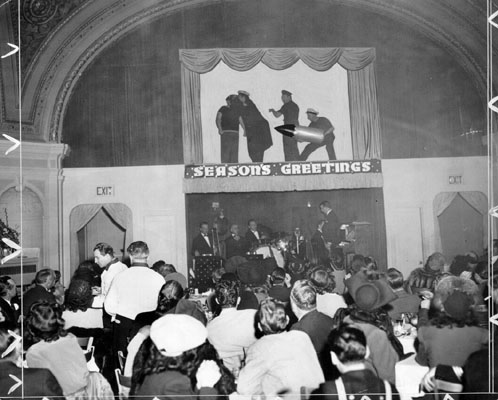First off, I have a guest blogger today,
The Strange Loves of Daniel Nauman, who loves vintage radios. He’s going to provide some interesting information about the old radio dials on the big beautiful pieces of furniture radios once were.
When I think of the old furniture style radios I think of people during the Depression sitting around listening to Roosevelt’s Fireside Chats. At those moments the country was one. They heard him tell of the Japanese attacking Pearl Harbor and the years of war that followed.
 Click on image to see it larger. (SOURCE: The American Magazine, October, 1936)
Click on image to see it larger. (SOURCE: The American Magazine, October, 1936)
On a lighter side I think of families gathering around to listen to their favorite comedies, dramas, and musical programs. Unlike today, where everything is in our face, listeners had to use their imaginations. I guess the closest today would be audio books and listening to
Prairie Home Companion.
Click on image to see it larger. (SOURCE: The American Magazine, October, 1936)
And now,
The Strange Loves of Daniel Nauman. Note that you can click on any of the images of radio dials below to see them larger.
___________________________ . . .
When Herb Bell’s mother complained that she couldn’t read the typically tiny dials found on early 1930s radios, he set out to do something about it. After all, he could---being co-founder of California’s own Packard Bell radios. He picked up on the latest 1935 trend of the full view round ‘airplane’ type dial but enlarged the size so he could print the station call letters above the frequency numbers. Their trademarked ‘Stationized’ dials were soon mimicked by many other California radio manufacturers.
The first image is from a late 1936 Packard Bell. You'll see some of the stations are in a larger font than the others, which indicates higher powered stations like KFI Los Angeles. KPO San Francisco would become KNBR (NBc Radio) in the 1950s. At 1560kc, W6AXI Bakersfield was above the commercial broadcast band at the time (550-1550kc) and therefore was stuck with an amateur’s call letters despite having a wide and eager audience for their high fidelity signal. Back in 1933, W6AXI was the audio source for the first regularly scheduled mechanical television broadcasts on the West Coast. A high school student sat before a broiling bank of lights and read the news from the evening paper.
The second image is of a 1936 Tiffany Tone dial, which incorporates a few stations from farther east, such as WFAA Dallas and Crosley Radio’s 500,000 watt superstation WLW Cincinnati. The lower short wave portion of the dial shows the principal cities and countries where short wave broadcasts originated.
The third image is of a 1937 Gilfillan 'Radio Log Dial'. This dial omits W6AXI, perhaps because of its experimental status. The dial does favor KGU Honolulu, however—so it’s likely Gilfillan had a distributor in Hawaii. Water greatly increases the range of AM broadcasts, so Hawaiians could take advantage of dials marked with KFI, KNX and KPO. I've also discovered that Gilfillan actually had different call letter dials for different markets on their little late 1930s Plastikon radios—such as one for the Salt Lake region, one for Seattle, etc. It's interesting they'd made the effort---and they must have advertised the fact, as it would be a good gimmick for a cheap plastic radio.
The fourth image is of a circa 1938 Tiffany Tone dial, showing the call letter change from experimental W6AXI to commercial KPMC (Pioneer Mercantile Company) when the broadcast band was increased up to 1600kc.
The fifth image is of a circa 1940 Remler. While most California radio manufacturers were based in Los Angeles, Remler was based in San Francisco, so it isn’t surprising their station list is mostly concerned with the Bay Area. Note the position of KQW San Jose on the dial.
Lastly, a Paramount dial, circa 1946. I believe this a rebranding of Remler, as once again the station list favors Northern California. KQW San Jose has been moved down to 740kc—its first step in becoming a high powered station, completed with its rebranding as KCBS about ten years later.
When civilian electronics production resumed after World War II, the majority of California radio manufacturers continued profiting from their military contracts due to the nascent Cold War. Within five years most ceased their consumer operations, unable or unwilling to compete on a nationwide scale. Only Packard Bell stuck with their trademark ‘Stationized’ dials into the early 1950s before vying for a share of the national market.
, , , ___________________________
Thank you Daniel!
Do you think
The Strange Loves of Daniel Nauman should be a blog? Let him know you enjoyed what he wrote by reaching him at thestrangelovesofdanielnauman@gmail.com.
































































